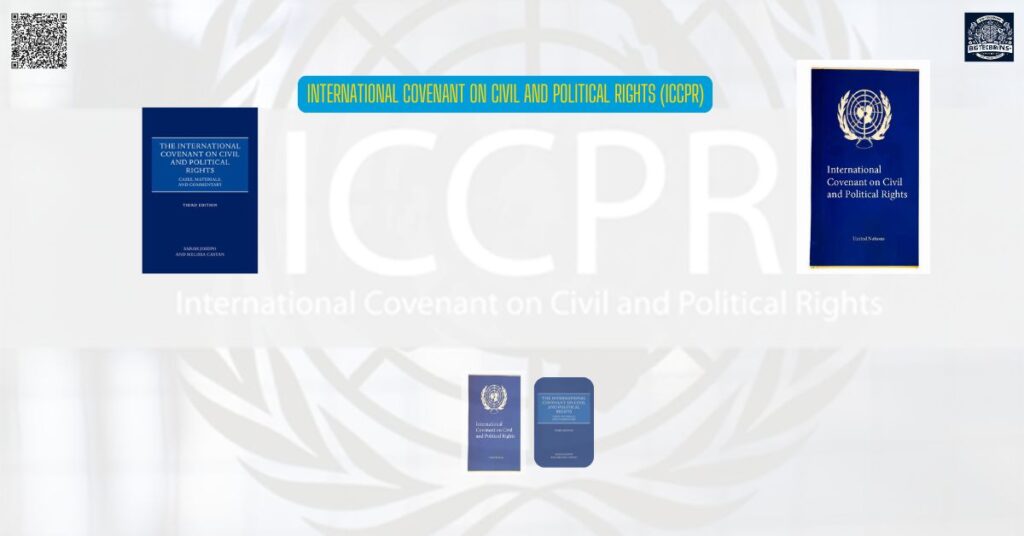Introduction
The International Covenant on Civil and Political Rights (ICCPR), adopted in 1966 and in force since 1976, is a cornerstone of international human rights law. Alongside the International Covenant on Economic, Social and Cultural Rights (ICESCR), it codifies the rights enshrined in the Universal Declaration of Human Rights (UDHR) into legally binding obligations. Ratified by 173 states (as of 2023), the ICCPR protects civil and political freedoms, such as the right to life, freedom of speech, and fair trial, while establishing mechanisms for accountability.
Historical Background
Origins:
- Developed in response to the need to translate the UDHR’s principles (1948) into enforceable law.
- Cold War divisions split human rights into two covenants: ICCPR (civil/political rights) and ICESCR (economic/social rights).
- Drafted by the UN Commission on Human Rights, with input from diverse legal systems.
Adoption:
- Adopted by the UN General Assembly on December 16, 1966.
- Entered into force on March 23, 1976, after 35 states ratified it.
Key Drafters:
- Eleanor Roosevelt, René Cassin, and delegates from Global South nations.
Key Provisions
The ICCPR comprises 53 articles divided into six parts:
Core Rights:
- Right to life (Article 6), including restrictions on the death penalty.
- Prohibition of torture and inhuman treatment (Article 7).
- Freedom from slavery (Article 8).
- Right to liberty and security (Article 9).
- Freedom of movement (Article 12).
- Equality before the law (Article 14).
- Freedom of thought, conscience, religion (Article 18).
- Freedom of expression (Article 19).
- Rights of minorities (Article 27).
Derogations:
- States may suspend certain rights during emergencies (e.g., war) but cannot violate non-derogable rights (e.g., prohibition of torture).
Optional Protocols:
- First Optional Protocol (1966): Allows individuals to submit complaints to the Human Rights Committee (HRC).
- Second Optional Protocol (1989): Aims to abolish the death penalty (ratified by 90 states).
Governance and Enforcement
Human Rights Committee (HRC):
- Monitors compliance through state party reports submitted every 4–5 years.
- Issues Concluding Observations with recommendations.
- Adopts General Comments interpreting ICCPR provisions (e.g., General Comment 34 on freedom of expression).
Individual Complaints:
- Under the First Optional Protocol, individuals can petition the HRC after exhausting domestic remedies.
- HRC’s decisions (“Views”) are non-binding but carry moral and political weight.
Inter-State Complaints:
- Rarely used (Article 41).
Membership and Reservations
State Parties:
- 173 ratifications (2023), including the U.S., UK, Germany, and India.
Non-Parties:
- China, Cuba, Saudi Arabia, and Myanmar.
Reservations:
- Some states limit obligations (e.g., U.S. reservations on juvenile death penalty).
Impact and Achievements
Legal Influence:
- Shaped national constitutions (e.g., South Africa, Colombia).
- Guided regional systems like the European Court of Human Rights.
Landmark Cases:
- Toonen v. Australia (1994): HRC ruled laws criminalizing homosexuality violate privacy rights.
- A.S. v. Hungary (2016): Condemned forced sterilization of Romani women.
Advocacy:
- Empowers NGOs (e.g., Amnesty International) to hold governments accountable.
Challenges and Criticisms
Weak Enforcement:
- HRC lacks authority to impose sanctions.
Selective Compliance:
- States ignore rulings (e.g., Philippines’ drug-war killings).
Cultural Relativism:
- Tensions over rights like gender equality and religious freedom.
Backsliding:
- Rising authoritarianism undermines ICCPR principles (e.g., Russia’s withdrawal from the First Protocol in 2023).
Recent Developments
Digital Rights:
- HRC’s General Comment 37 (2020) affirmed rights to peaceful assembly in digital spaces.
Climate Justice:
- Emerging debates on linking ICCPR to environmental harms.
75th Anniversary of UDHR (2023):
- Renewed focus on ICCPR’s role in protecting civic space.
References
Full Text of ICCPR:
Human Rights Committee:
- https://www.ohchr.org/en/instruments-mechanisms/instruments/international-covenant-civil-and-political-rights
Optional Protocols:
- https://treaties.un.org/doc/Treaties/1976/03/19760323%252006-17%2520AM/Ch_IV_5.pdf
- https://treaties.un.org/doc/Treaties/1991/07/19910711%252005-18%2520AM/Ch_IV_12.pdf
Academic Resources:
- Joseph, S., & Castan, M. (2013). The International Covenant on Civil and Political Rights: Cases, Materials, and Commentary.
- Nowak, M. (2005). UN Covenant on Civil and Political Rights: CCPR Commentary.
NGO Reports:
- https://www.hrw.org/
- https://www.amnesty.org/

